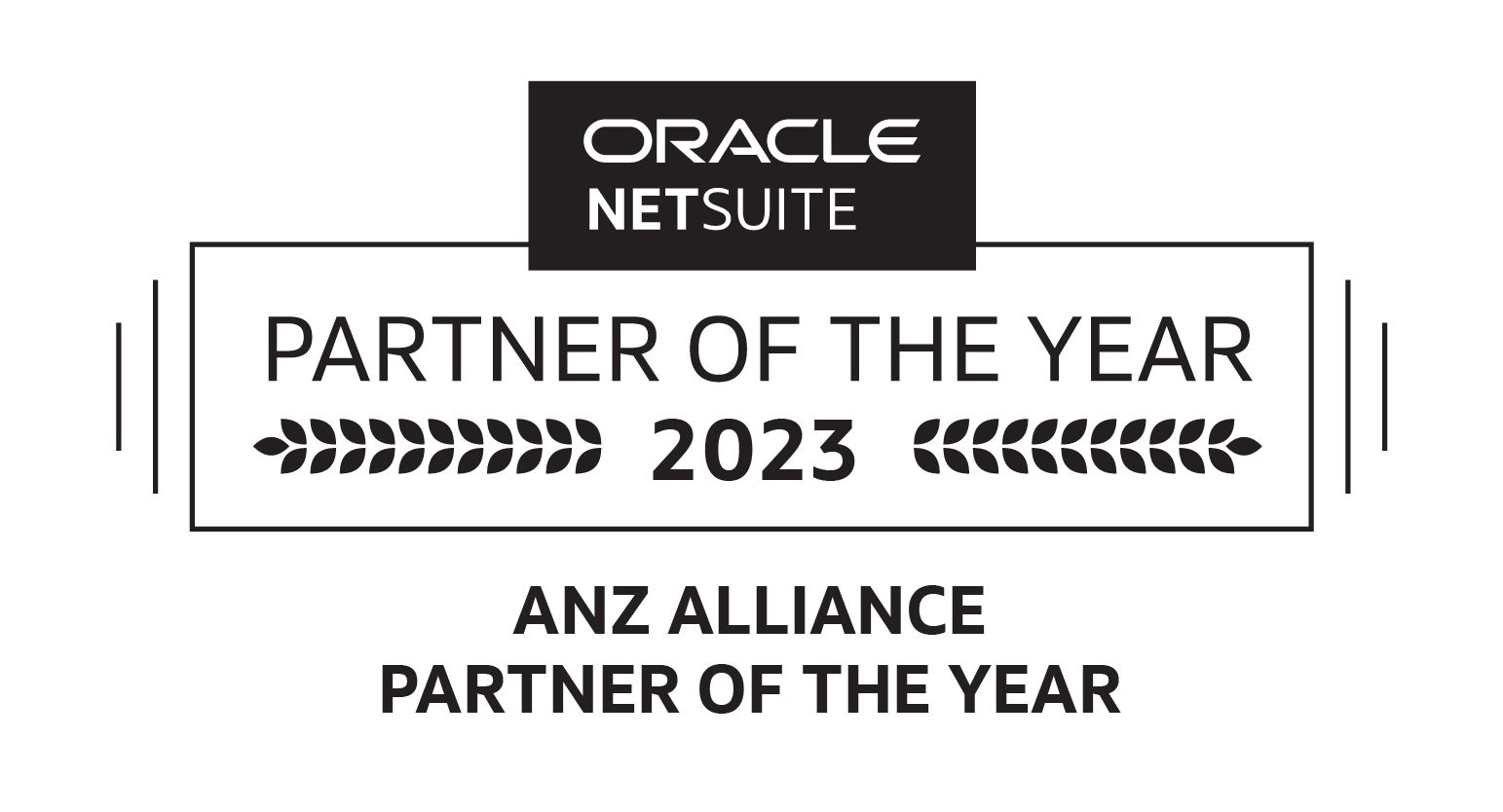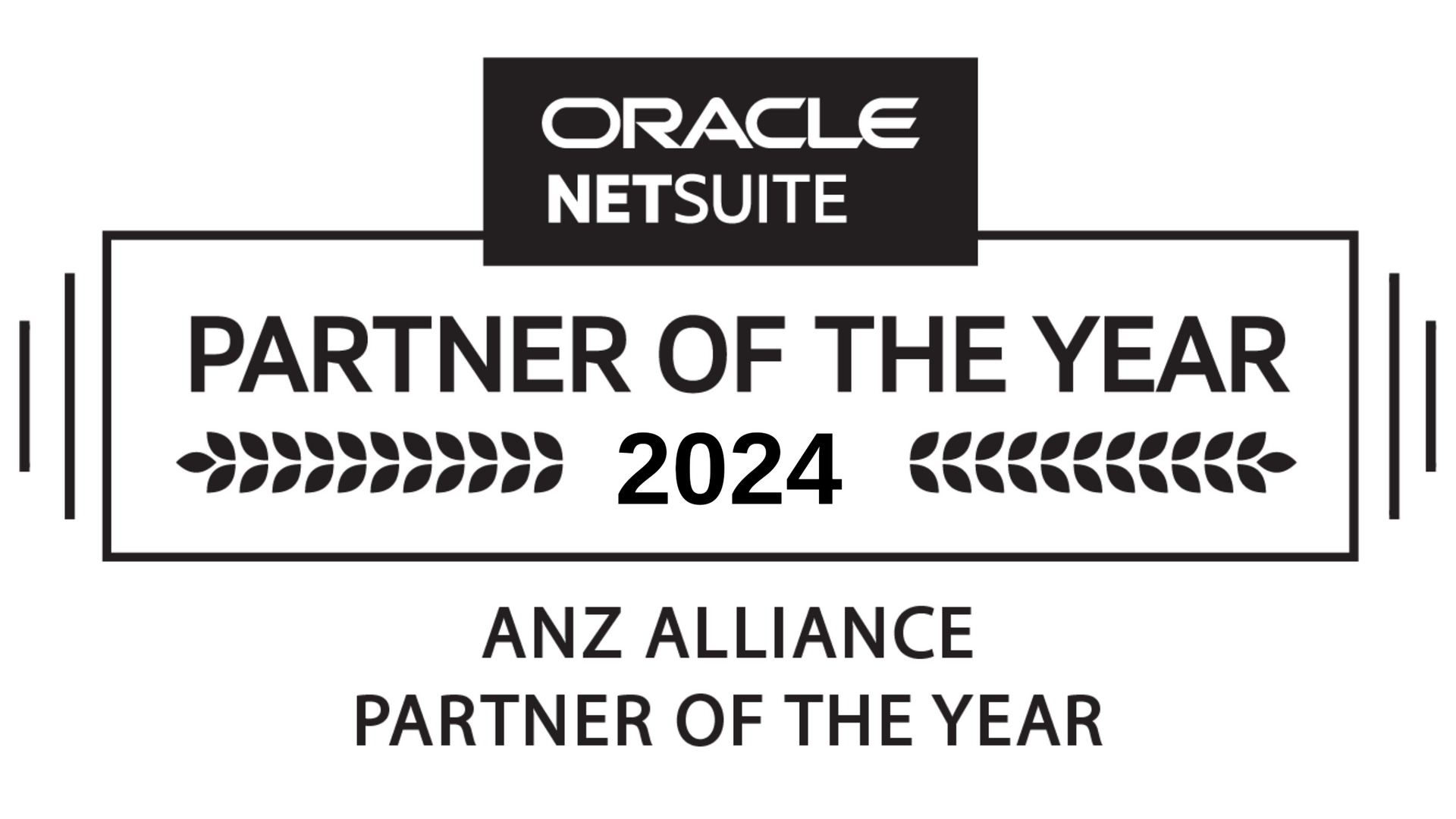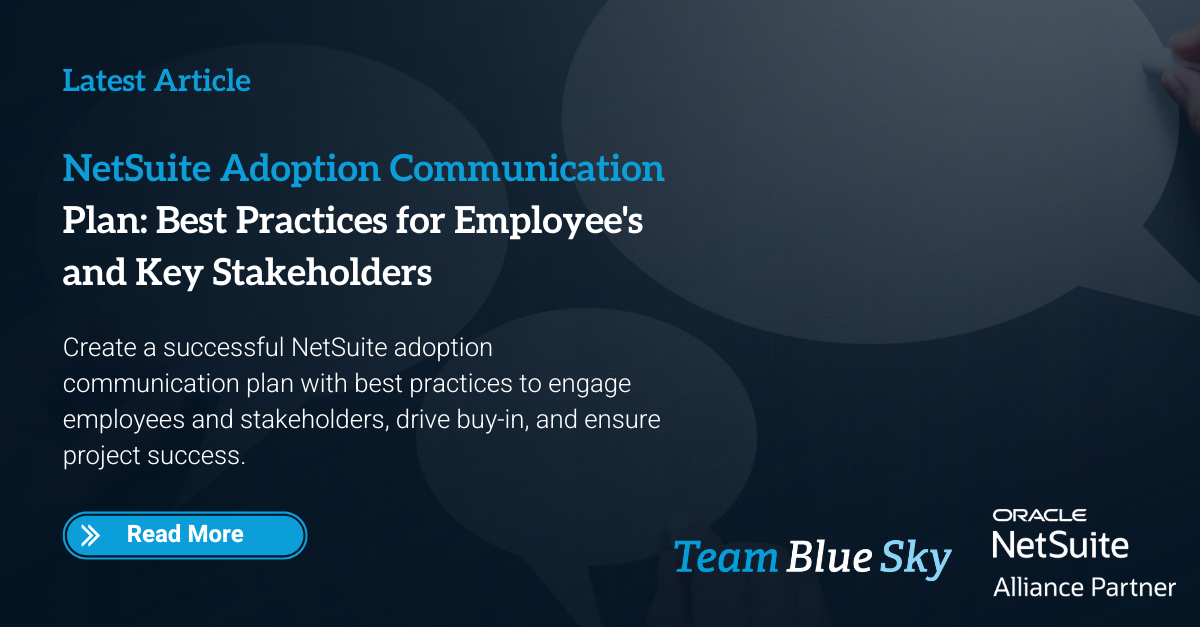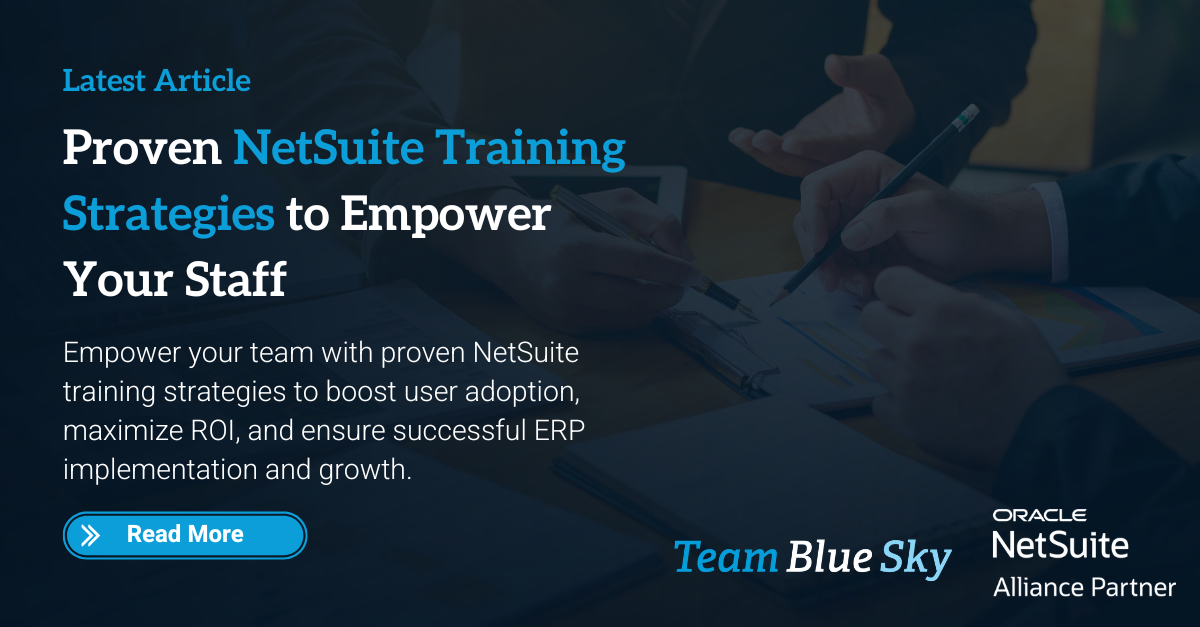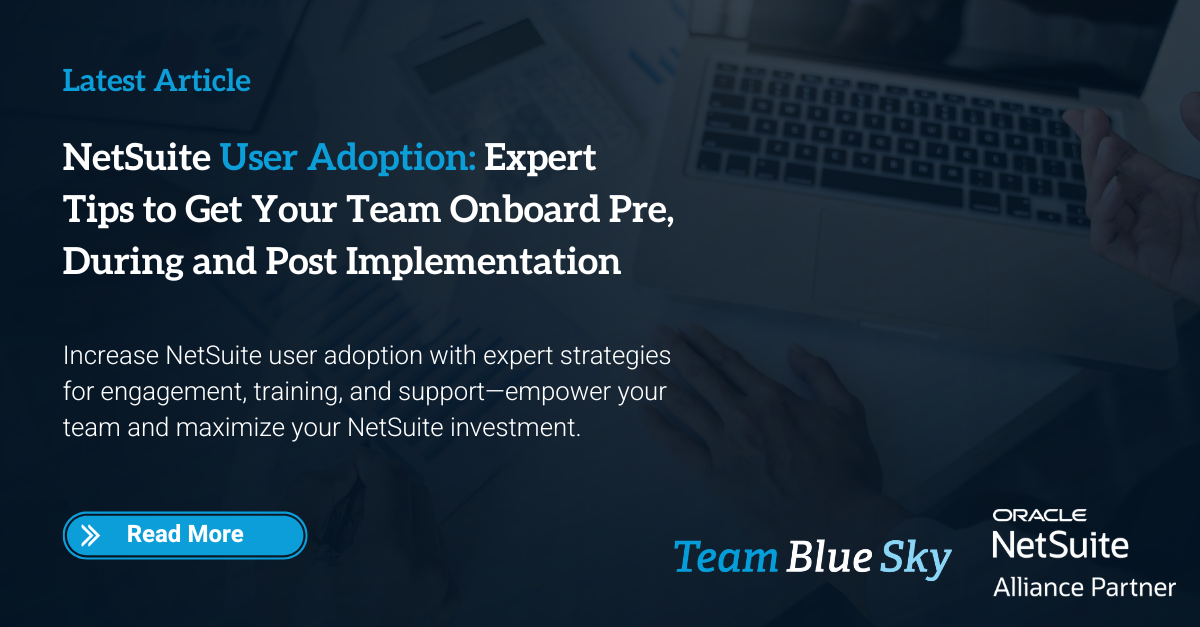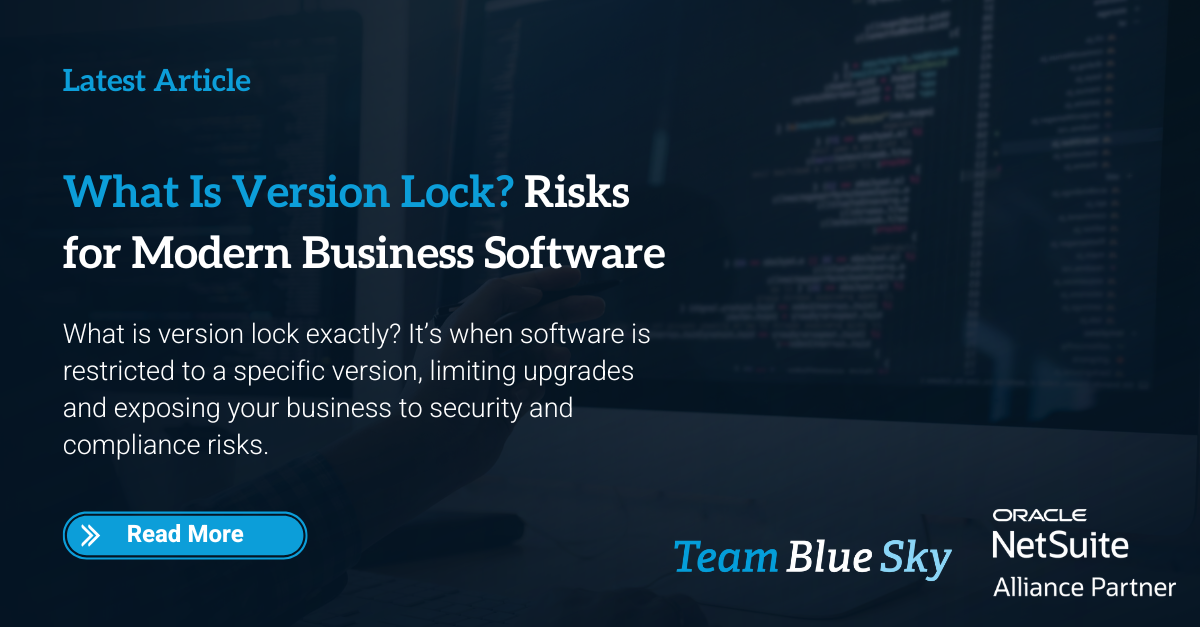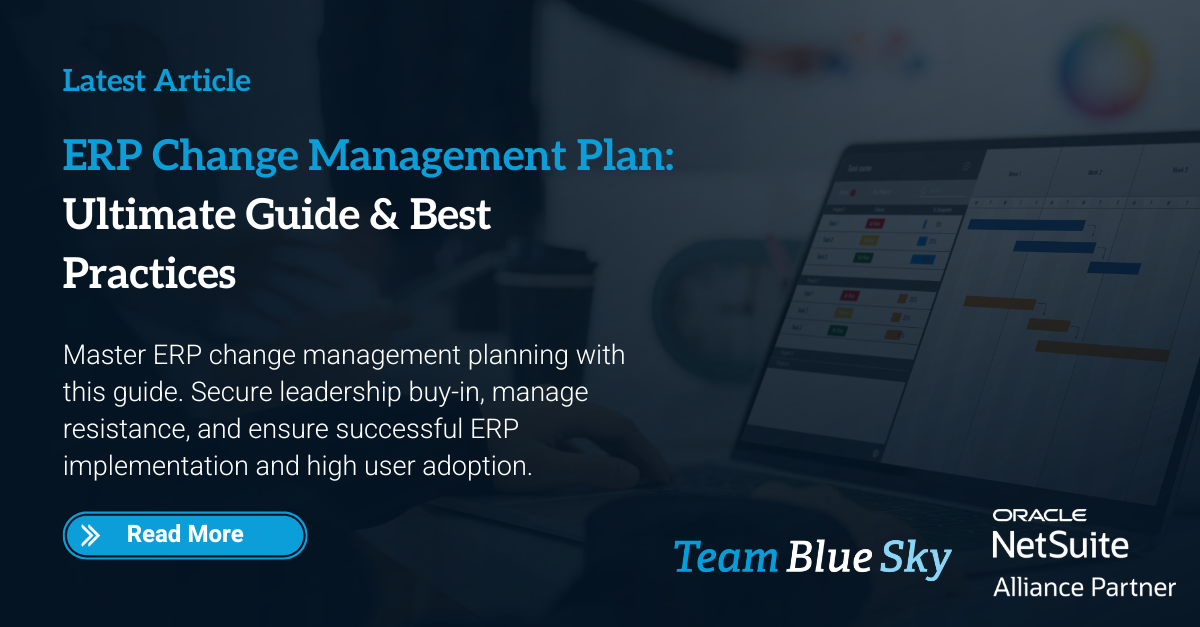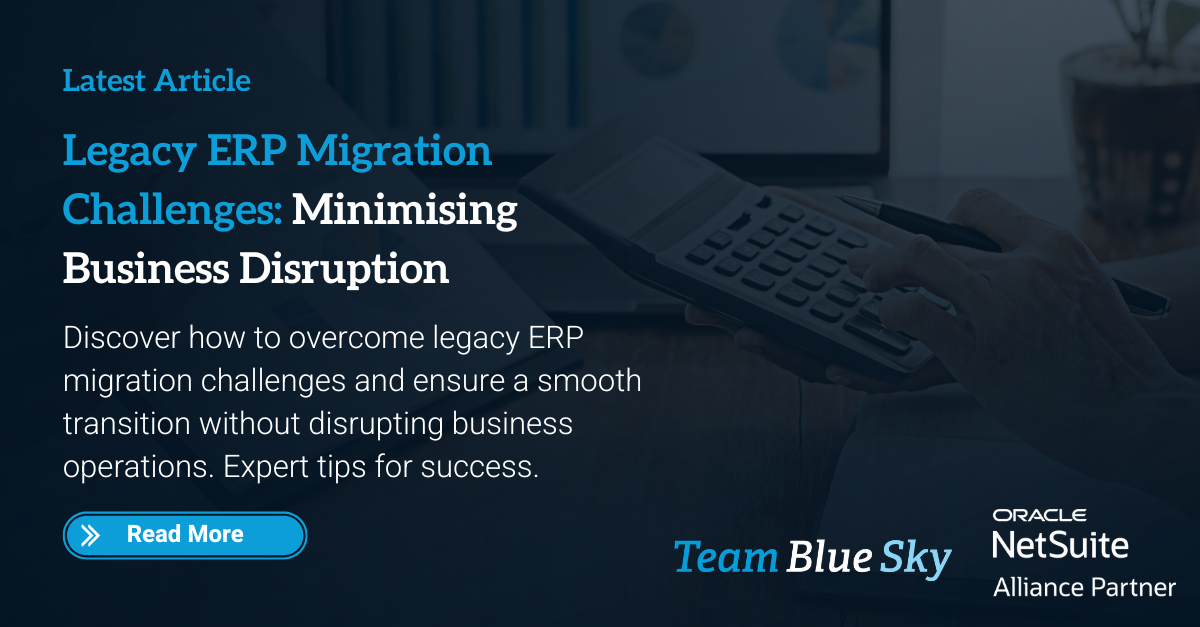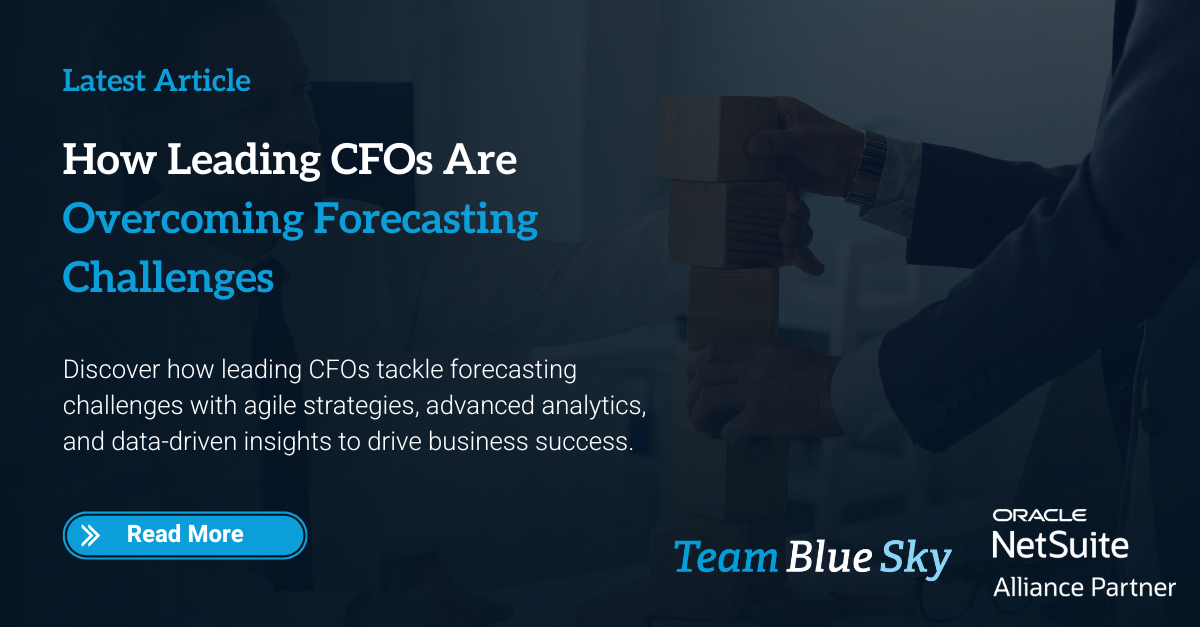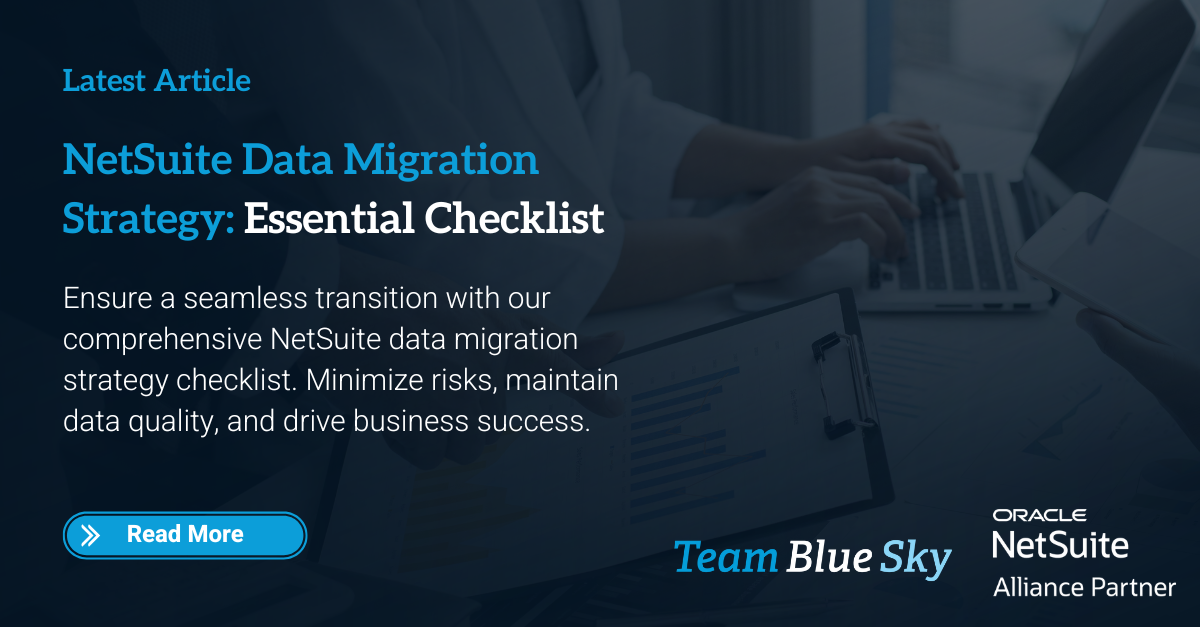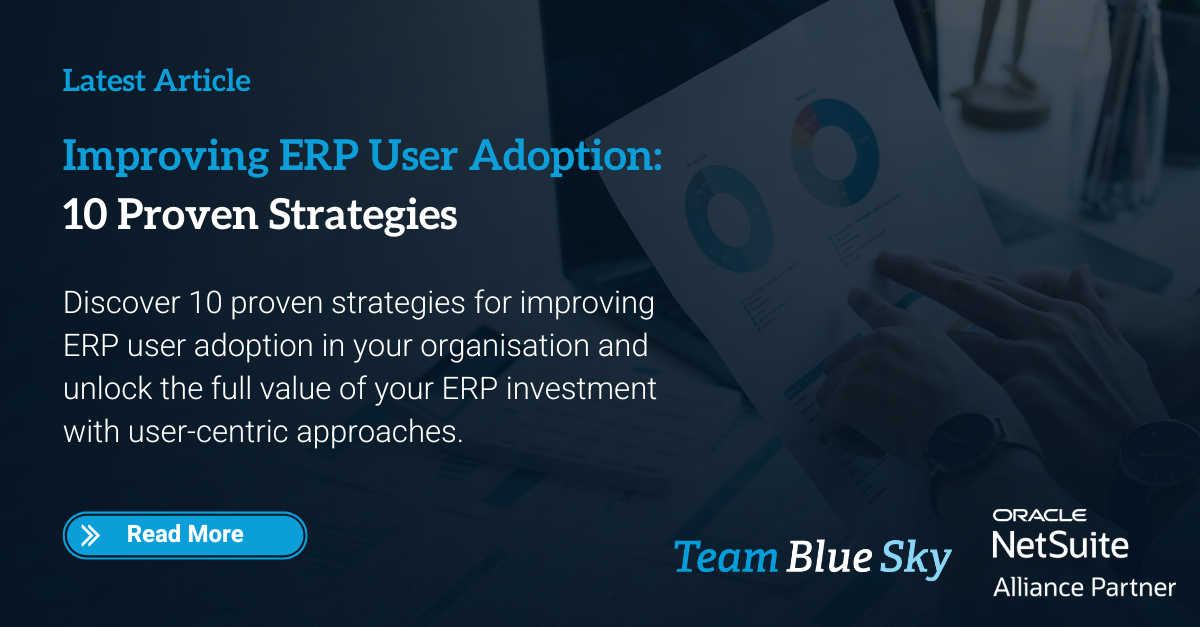You’ve Chosen Netsuite! Now It’s Time to Get Your ERP Migration Plan in Order
If your company is migrating to NetSuite ERP, congratulations! You’ve made a wise decision that will put you ahead of the competition and streamline your business processes. However, implementing an Enterprise Resource Planning (ERP) system can be a complex process, requiring careful planning and execution. The moving from legacy systems to a modern ERP solution is a challenging process that demands a structured approach to ensure successful data migration and implementation. In this article, we will outline an effective ERP upgrade plan, considering crucial components such as migration process, strategy, team, project, and successful data migration.
TL:DR
Planning Your ERP Migration Process
The migration process sets the foundation for a successful ERP implementation. It involves identifying the sources of data, mapping data fields, and defining the various stages of implementation. A methodical approach ensures that efforts result in a smooth transition from the existing systems to the new ERP solution. Historical analysis of data can also help to identify redundant data such as non-current customer names or suppliers you no longer work with.
Building a ERP Migration Strategy
Developing a ERP upgrade strategy is key to the success of the ERP implementation project. A well-defined strategy outlines the objectives, business goals, and business requirements of the migration. It also considers the integration capabilities and earlier integration requirements, ensuring a seamless transition and minimal disruption to business operations.
Assemble Your ERP Migration Team
Building a competent team is essential for a successful ERP project. The team should consist of skilled professionals with extensive experience in ERP implementations. They should possess a deep understanding of business processes and be able to handle complex processes and internal conflicts. Assigning a dedicated team helps maintain focus and ensures efficient execution.
Create a Detailed Migration Project Plan
A well-structured migration project plan is vital for effective project management. It includes setting timelines, defining deliverables, and establishing accountability. The plan should consider the implementation budget, ensuring adherence to financial constraints. Contingency plans should also be in place to address unforeseen challenges and mitigate risks.
Define What Successful Migration Looks Like for Your Company
Successful ERP comes down to careful planning, data cleansing, and verification processes, which are essential to ensure data integrity and avoid file glitches. The migration team must establish a source of truth and a single source for accurate and reliable data. Implementing an initial data cleansing method helps eliminate duplicate items, and duplicative customer data, and ensures complete item records.
Partner with an Expert Implementation Team
Partnering with an external implementation team to oversee the entire implementation process increases your chances of success. A good ERP partner will also focus on broader business initiatives and organisational change management. They are there to ensure that the new ERP system aligns with the business processes and provides the necessary functionality for a successful go-live.
Align Your Business Processes
Consideration of business processes is crucial during an ERP implementation. The plan should address how the new ERP solution will support and improve business operations. It should integrate workflows and provide the necessary integration layer to streamline supply chain processes. The plan should encompass the entire supply chain, from customer demands to centralised locations, enabling efficient operation.
Understanding the Importance of a Well-Planned ERP Migration Strategy
A well-planned ERP migration ensures that your business operations continue seamlessly across all departments and locations during and after the go-live. This minimises downtime and maximises efficiency, saving your business time and money in the long run. A poorly planned project can lead to data loss, security risks, and business disruption.
The benefits of a successful migration project:
With a successful ERP migration plan in place, you can enjoy the following benefits:
- Streamlined business processes
- Higher productivity and efficiency
- Enhanced customer and supplier connectivity
- Better visibility into business operations
- Reduced IT complexity and maintenance costs
Streamlined business processes can lead to faster turnaround times for customer orders, increased efficiency in supply chain management, and better inventory management. The enhanced connectivity with customers and suppliers can lead to improved communication, resulting in better collaboration and more opportunities for growth. Better visibility into business operations can help identify areas for improvement and optimisation, leading to increased profitability.
Furthermore, reducing IT complexity and maintenance costs can lead to significant cost savings for your business. By implementing a successful NetSuite ERP migration plan, you can eliminate the need for multiple software applications and systems, reducing the need for IT personnel and related expenses.
Risks of a poorly planned migration
On the other hand, a poorly planned NetSuite ERP migration has the following risks:
- Loss of critical data and business continuity
- Increased security risks
- Disruption to business operations
- Extended downtime and lost revenue
Loss of critical data can lead to significant setbacks for your business, including lost revenue, decreased productivity, and damage to your reputation. Increased security risks can lead to data breaches and cyber attacks, resulting in loss of sensitive information and financial loss. Disruption to business operations can lead to missed deadlines, decreased customer satisfaction, and lost revenue. Extended downtime can lead to lost revenue and decreased productivity.
Step 1. Assessing Your Current ERP System: A ERP Migration Checklist
Before you start planning your NetSuite ERP migration, it is important to assess your current ERP system thoroughly. This will help you identify the key data and processes that must be migrated to the new system.
Identifying key data and processes
To begin with, take stock of your existing data and processes, and identify what needs to be moved over to NetSuite ERP. This includes customer records, transactions, inventory management, financial reports, and accounting data. It is essential to identify all the data that needs to be migrated to ensure that the new system functions smoothly and meets your business requirements.
As you assess your current ERP system, it is also important to identify any gaps or inefficiencies in your existing processes. This will help you streamline your processes and optimise them for the new system.
Evaluating system customisations
If you have customised your current ERP system, it is crucial to evaluate and document these customisations. This includes reports, forms, workflow processes, and any unique interfaces with other systems. Understanding the customisations in your current system will help you determine which ones to migrate to NetSuite and which ones to retire or replace.
It is important to keep in mind that not all customisations may be necessary or relevant in the new system. Therefore, evaluating and documenting these customisations will help you make informed decisions when planning your NetSuite ERP project.
Overall, assessing your current ERP system is a critical step in planning a successful NetSuite ERP migration. By identifying key data and processes and evaluating system customisations, you can develop a comprehensive plan that meets your business requirements and streamlines your processes.
Step 2. Building Your NetSuite ERP Migration Team
Building a skilled and experienced NetSuite ERP team is critical to the success of your plan. The team should comprise:
Roles and responsibilities
- A project manager to oversee the entire project and ensure timely delivery
- A functional lead to manage business processes and data
- A technical lead to manage customisation and integration of systems
- A data analyst to manage data cleansing, consolidation and transformation.
However, building a team is not just about filling specific roles. It is also about finding team members who work well together and can collaborate effectively. Look for individuals who have experience working in a team environment and who are willing to go above and beyond to ensure the success of the project.
Ensuring effective communication
Ensure your team members have clear roles, responsibilities, and communication channels. Regular meetings, progress reports, and feedback sessions are essential to ensure that the entire team is up to speed with the migration progress and any issues that arise.
Effective communication is not just about having regular meetings. It is also about creating an environment where team members feel comfortable sharing their ideas and concerns. Encourage open communication and provide a safe space for team members to express their thoughts and opinions.
Another way to ensure effective communication is by using collaboration tools. There are many tools available that can help your team collaborate more efficiently, such as project management software, instant messaging apps, and video conferencing tools.
Training and development
Investing in the training and development of your team members can also help ensure the success of your migration plan. Provide your team members with the necessary training and resources to help them develop their skills and knowledge.
Encourage your team members to attend industry events, webinars, and training sessions to stay up to date with the latest trends and best practices in NetSuite integration and migration. This will not only benefit your team members but also your organisation as a whole.
By building a skilled and experienced NetSuite ERP migration team, ensuring effective communication, and investing in the training and development of your team members, you can ensure the success of your migration plan and achieve your business goals.
Step 3. Developing a Comprehensive ERP Migration Project Plan
A comprehensive ERP implementation plan forms the backbone of a successful NetSuite ERP migration. It is essential to have a well-planned and executed process to ensure a smooth transition from your existing ERP system to NetSuite.
Developing a comprehensive migration plan involves various steps, including defining the project scope and objectives, creating a detailed timeline, and establishing a budget and resource allocation.
Defining Project Scope and Objectives
Defining the project scope and objectives is the first step towards developing a comprehensive migration plan. The scope should cover all the aspects of the process, including data migration, configuration, customisation, testing, training, and support.
It is essential to identify the objectives of the migration process, such as improving efficiency, reducing costs, increasing productivity, and enhancing the overall performance of the ERP system.
Identifying potential risks and developing contingency plans to mitigate them is also crucial in this stage. This ensures that the process is not affected by any unforeseen circumstances.
Creating a Detailed Timeline
Developing a detailed timeline is critical to ensure that the project is well-coordinated and completed on time. The timeline should outline all the tasks and deliverables involved in the project, along with timelines, dependencies, and milestones.
The timeline should also include the testing and training phases to ensure that the users are well-equipped to use the new system effectively.
It is essential to allocate sufficient time for each task and ensure that the timeline is realistic and achievable. Regular monitoring and updates to the timeline are necessary to ensure that the project stays on track.
Establishing a Budget and Resource Allocation
Allocating the necessary resources is crucial to ensure a successful migration. This includes budget, staffing, and technical resources.
It is essential to establish a budget that covers all the costs associated with the project, including hardware and software, consulting fees, and training costs.
Staffing is also critical to ensure that the project is well-executed. It is essential to allocate the right resources with the necessary skills and experience to ensure a successful migration.
Technical resources, including hardware and software, should be allocated based on the requirements of the project. It is essential to ensure that all the resources are available and well-coordinated throughout the migration process.
Step 5. Planning for Data Migration and Integration
Data migration and integration is a crucial step in the ERP implementation. This includes:
Data cleansing and preparation
Cleanse and prepare all the existing data for migration to NetSuite ERP. This includes data analysis, data normalisation, data mapping, and data validation. This step helps ensure that the migrated data is accurate, consistent, and complete.
During the data cleansing and preparation process, it is important to identify any duplicate data or inconsistencies in the data. This can be a time-consuming process, but it is critical for ensuring that the data is accurate and reliable. It is also important to ensure that any data that is not relevant or necessary for the migration is removed to avoid cluttering the new system with unnecessary data.
Ensuring data accuracy and integrity
Ensure the accuracy and integrity of the data throughout the process. Building processes to track data quality, validate data across systems and perform audits to verify data accuracy are necessary steps.
One way to ensure data accuracy and integrity is to establish data governance policies and procedures. This includes defining data standards, establishing data quality metrics, and implementing data validation rules. It is also important to establish a data stewardship program to ensure that data is maintained and updated regularly.
Integrating with existing systems
Integrate your current systems and third-party software with NetSuite ERP, as required. This includes ensuring connectivity, validating data interfaces, and building and testing custom integrations as necessary.
Integrating with existing systems can be a complex process, especially if there are multiple systems involved. It is important to have a clear understanding of the data flow between systems and to ensure that the data is synchronised across all systems. This can be achieved through the use of middleware or custom integration solutions.
In addition, it is important to ensure that the integration does not disrupt existing business processes. This requires careful planning and testing to ensure that the integration is seamless and does not cause any downtime or data loss.
Conclusion
By following these essential steps, your NetSuite ERP migration plan will be well-planned, well-executed, and successful. With proper planning, communication, and teamwork, your business will reap the benefits of a streamlined, efficient, and advanced ERP system.
Are you ready to take your business to the next level with a seamless NetSuite implementation? Consider TeamBlueSky, Australia's leading NetSuite Alliance Partner. Our experienced team, led by Henry Sack, GM of TeamBlueSky, is dedicated to delivering successful ERP implementations and ensuring your business achieves its goals.
Why Choose TeamBlueSky?
We bring a methodical approach, extensive experience, and a commitment to excellence. With our expertise in data migration, business process alignment, and organisational change management, we have what it takes to make your NetSuite implementation a resounding success.
Partnering with TeamBlueSky means gaining access to a dedicated team that understands the complexities of ERP implementation. We prioritise data integrity, ensuring your valuable information is accurate, reliable, and seamlessly transferred to your new system. Our focus on business processes guarantees that your operations will be optimised, workflows streamlined, and supply chain processes enhanced.
If you are interested in learning more about how TeamBlueSky can help you with your ERP migration, contact us today.

Henry Sack
General Manager

With over 12 years of experience as a NetSuite implementation consultant, Henry Sack leads TeamBlueSky’s team of NetSuite and accounting experts in his role of General Manager.
TeamBlueSky is a leading Australian
NetSuite Alliance Partner whose mission is to provide critical
NetSuite BPO and
Payroll services to NetSuite clients who are wanting to simplify their
back office processes and partner with a leading
NetSuite administration expert.
TeamBlueSky have also partnered with global Suite Developer Network partners to offer local solutioning, implementation and support services for global NetSuite SuiteApps.


